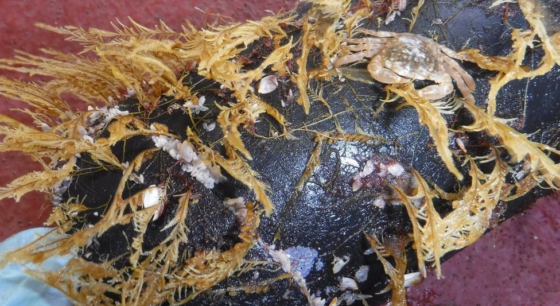
Plastic is providing a new habitat for coastal species in the ocean, study finds

Ocean plastic is providing a habitat for a new community of otherwise coastal species, according to a new commentary published in the peer-reviewed journal, Nature Communications.
The authors reported coastal species growing on pollution hundreds of miles out to sea in the North Pacific Subtropical Gyre, more commonly known as the “Great Pacific Garbage Patch.”
The world has at least five of these plastic-infested gyres, or “garbage patches,” which consist of floating debris as well as microplastics. Gyres form when surface currents drive plastic pollution from the coasts into regions where rotating currents trap the floating objects, which accumulate over time.

Debris with coastal and open-ocean organisms. Photo courtesy of The Ocean Cleanup/Smithsonian Institution
The authors of the study, including two oceanographers from the University of Hawaiʻi at Mānoa School of Ocean and Earth Science and Technology, found that these new communities of plants and animals could represent “significant ecological shifts in the marine environment.” The communities have been named “neopelagic” – neo means new and pelagic refers to the open ocean.
However, the authors say they still do not know how common neopelagic communities are, or whether they can sustain themselves.

Anika Albrecht of Ocean Voyages Institute collecting plastic. Photo courtesy of Ocean Voyages Institute
Scientists first began to suspect that coastal species could use plastic as a habitat to survive in the ocean for long periods after the Japanese tsunami of 2011. For the first time in recorded history, scientists detected entire communities of coastal species crossing the Pacific by floating on makeshift rafts of tsunami debris, from Japan towards Hawaii and the US West Coast.
For marine scientists, the very existence of a neopelagic community is a paradigm shift.
“The issues of plastic go beyond just ingestion and entanglement,” said Linsey Haram, lead author of the article and former postdoctoral fellow at the Smithsonian Environmental Research Center. “It’s creating opportunities for coastal species’ biogeography to greatly expand beyond what we previously thought was possible.”
The study’s authors observed floating debris such as tangled fishing nets, buoys, old toothbrushes and floating water bottles.
“The open ocean has not been habitable for coastal organisms until now,” said SERC senior scientist Greg Ruiz, who heads the Marine Invasions Lab where Haram worked. “Partly because of habitat limitation—there wasn’t plastic there in the past—and partly, we thought, because it was a food desert.”
Scientists estimate cumulative global plastic waste could reach over 26 billion tonnes by 2050. With fiercer and more frequent storms on the horizon thanks to climate change, the authors say they expect even more of that plastic will get pushed out to sea. Colonies of coastal rafters on the high seas will likely only grow. This long-overlooked side effect of plastic pollution, the authors say, could soon transform life on land and in the sea.
